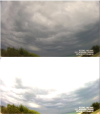Just adding a point of data.
If you watch footage of bright fireballs, especially if the camera is pointed directly at them the images brightness/aperture adjusts.
This can be seen as the point of light overwhelming the image, then the rest of the scene darkens relative to the source of bright light as the hardware compensates. It is then followed by a further adjustment if the light source is removed or fades suddenly, the whole scene will appear dark and then readjust brighter.
You can see the guys camera do this. At the start where he points towards the sun before sitting down - the camera is adjusting the overall brightness of the image down (darkening) as he sits down. The path/clouds are much darker by comparison, and the camera readjusts after a second to balance the input.
Having looped this, you can see the camera adjusts in these periods after about half a second.
Where it does not balance is with the flash of the meteor. The entire scene brightens. This should not happen.
Given the light from the meteor lasts many seconds and then fades abruptly you should see balancing in both direction - firstly as it gets brighter, the brightness of everything else in the image gets turned down. Then one it's gone, everything should appear dark for half a second or so.
What I do see happening is the entire scene brightening, which suggests a photoshop style image filter and poor knowledge of cameras.
To prove the point, attached is a still I photoshopped in a few minutes (just turn up contrast/brightness).
Compare to the brightness of the plants to the brightest point of the meteor on the video - the entire scene is brightened with no sign of the camera adjusting.
The following video shows how a camera should respond - compare and contrast the brightness of the object vs the brightness of the rest of the image.

